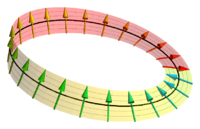
Photo from wikipedia
Second harmonic generation (SHG) is a fundamental nonlinear optical phenomenon widely used both for experimental probes of materials and for application to optical devices. Even-order nonlinear optical responses including SHG… Click to show full abstract
Second harmonic generation (SHG) is a fundamental nonlinear optical phenomenon widely used both for experimental probes of materials and for application to optical devices. Even-order nonlinear optical responses including SHG generally require breaking of inversion symmetry, and thus have been utilized to study noncentrosymmetric materials. Here, we study theoretically the SHG in inversion-symmetric Dirac and Weyl semimetals under a DC current which breaks the inversion symmetry by creating a nonequilibrium steady state. Based on analytic and numerical calculations, we find that Dirac and Weyl semimetals exhibit strong SHG upon application of finite current. Our experimental estimation for a Dirac semimetal Cd$_3$As$_2$ and a magnetic Weyl semimetal Co$_3$Sn$_2$S$_2$ suggests that the induced susceptibility $\chi^{(2)}$ for practical applied current densities can reach $10^5~\mathrm{pm}\cdot\mathrm{V}^{-1}$ with mid-IR or far-IR light. This value is 10$^2$-10$^4$ times larger than those of typical nonlinear optical materials. We also discuss experimental approaches to observe the current-induced SHG and comment on current-induced SHG in other topological semimetals in connection with recent experiments.
Journal Title: Physical Review B
Year Published: 2021
Link to full text (if available)
Share on Social Media: Sign Up to like & get
recommendations!